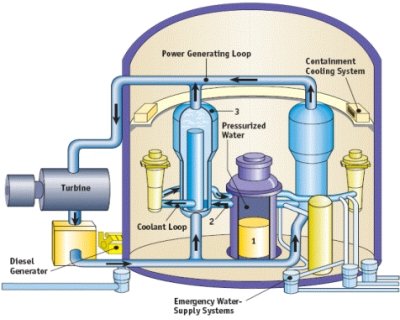Seabrook Nuclear Generating Station, New Hampshire
Next Update: October 2009
Seabrook Nuclear Generating Station
Net Generation and Capacity, 2007
Unit |
Net Capacity |
Generation |
Capacity |
Type |
On Line |
License |
| 1 | 1,244 | 10,763.884 | 98.8 | PWR | August 19, 1990 | October 17, 2026 |
|
PWR = Pressurized-Water Reactor. Sources |
||||||
Description: Seabrook Station is located on an 889-acre site that is 13 miles south of Portsmouth, New Hampshire. It has the largest reactor in New England and provides about 7 percent of the region’s electricity. On November 1, 2002, the FPL Group (representing Florida Power & Light), announced acquisition of controlling interest in the Seabrook plant. According to the FPL web site, the FPL Group acquired 88.2 percent interest in the plant for a total of $837 million. FPL notes that water used in the reactor and most other plant systems is piped in from the municipal water supply, then purified and tested. A separate water supply is drawn from the Atlantic Ocean to cool used steam for re-use. This separate supply does not come into contact with the reactor system, but it is monitored before being returned to the ocean through pipes located offshore. The plant has a visitor center, the Seabrook Science & Nature Center.
Seabrook, Unit 1
Nuclear Steam System Supplier (NSSS vendor) = Westinghouse
Architect Engineer = United Engineers & Constructors
Owners: FPL Energy, Inc. (88.2 percent), Massachusetts Municipal Wholesale Electric Company (11.6 percent), Taunton Municipal Lighting Plant (0.1 percent), and Hudson Light & Power Department (0.1 percent)
Operator: FPL Group, Inc.
Pressurized-Water Reactor (PWR)
In a typical commercial pressurized light-water reactor (1) the reactor core generates heat, (2) pressurized-water in the primary coolant loop carries the heat to the steam generator, (3) inside the steam generator heat from the primary coolant loop vaporizes the water in a secondary loop producing steam, (4) the steam line directs the steam to the main turbine causing it to turn the turbine generator, which produces electricity. The unused steam is exhausted to the condenser where it is condensed into water. The resulting water is pumped out of the condenser with a series of pumps, reheated, and pumped back to the steam generator. The reactors core contains fuel assemblies which are cooled by water, which is force-circulated by electrically powered pumps. Emergency cooling water is supplied by other pumps, which can be powered by onsite diesel generators. Other safety systems, such as the containment cooling system, also need power.
 |
| © U.S. Nuclear Regulatory Commission |
Containment: According to the U.S. Nuclear Regulatory Commission, the containment is dry, ambient pressure.1
_________________________________________
extrafootnote
1Dry, Ambient Pressure: a reactor containment design whose safety has been evaluated on the basis of having a dry air atmosphere at ambient pressure (0 psig) prior to the onset of a loss of coolant accident or steam pipe break. The containment design (concrete and steel tendons) must be able to take the full thermal and pressure stresses associated with the rapid energy release (steam) from a major pipe break.
Sources for Data in Table: Capacity, for purposes of this report, is the net summer capability as reported in Energy Information Administration (EIA) Form EIA-860, "Annual Electric Generator Report." Capacity Factor is a percentage calculation in which the maximum possible generation (based on net summer capability) is divided into the actual generation then multiplied by 100. Generation is the net electricity output reported by plant owners on Form EIA-906, “Power Plant Report.” Type of Unit: All U.S. commercial reactors currently in operation are one of two types: BWR (boiling water reactor) or PWR (pressurized light water reactor). The type, on-line date, and the license expiration date are published annually in Information Digest by the U.S. Nuclear Regulatory Commission.